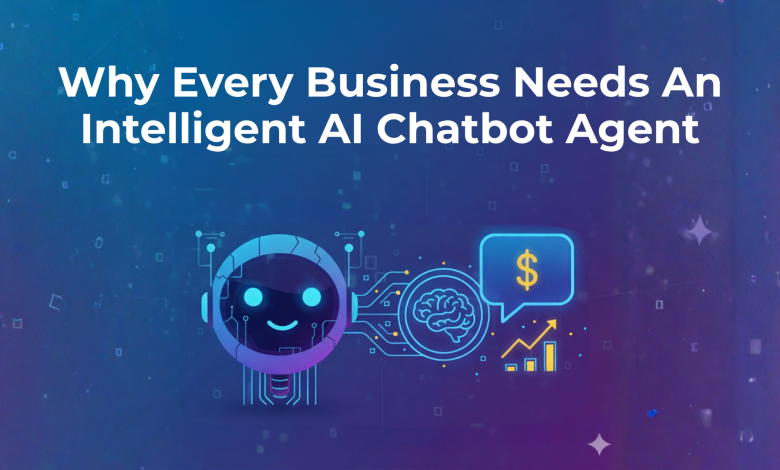
Customers expect help right away. They want answers that are quick, accurate, and available at any hour. Waiting on hold or trading long email threads feels outdated. When a company takes too long to reply to queries or makes people ask the same information repeatedly the trust erodes. Intelligent AI chatbot agents change that. AI chatbot guides customers through questions, purchases, and problems in real time. A well built AI chatbot agent recognizes intent, reads tone, and adapts to the situation.
Companies that rely only on manual replies or slow ticket systems fall behind. Competitors that use intelligent chatbots deliver smoother experiences and faster resolutions. The result is higher satisfaction, stronger loyalty, and a brand that feels responsive. A chatbot becomes part of a company’s communication system. It reduces staff workload, cuts operational costs, and provides data that sharpens decisions. Chatbots are now useful in customer support, sales, marketing, human resources, and e commerce.
What makes an AI chatbot intelligent
Not every chatbot deserves the label intelligent. Older systems ran on simple decision trees. Those bots followed rigid scripts and gave the same reply when a keyword matched. They failed if someone used slang, made typos, or asked something slightly different. Conversations ended in dead ends.
Modern AI chatbots use natural language processing and machine learning to understand what people mean, not just what they type. Natural language processing lets the bot parse grammar, detect tone, and find context. Machine learning helps it improve with each interaction.
An intelligent chatbot can:
- Understand intent even when users type casually or make mistakes
- Recognize slang, informal speech, or mixed languages
- Remember previous chats and recall customer preferences
- Suggest solutions or products based on behavior patterns
- Learn from outcomes to respond more accurately next time
This ability to learn and adapt makes conversations feel human. The chatbot can say welcome back, remember what a customer bought last time, or follow up on a previous issue. Those small touches build familiarity and care. Over time, they create trust and loyalty.
Key benefits of using an intelligent chatbot
Adding an intelligent chatbot is like adding a team member who never sleeps, never loses patience, and never misses a message. The benefits are useful for both customers and the company.
Round-the-clock customer support
A chatbot stays online. Whether it is midnight in one region or midday in another, the bot provides consistent service. For global businesses, 24/7 support keeps customers from waiting until business hours. Support teams get to rest while the chatbot handles routine inquiries.
Instant responses that build trust
Speed matters. Quick replies make customers feel heard. Even short delays can send a person to a competitor. A chatbot responds in seconds. It confirms requests, shares information, and solves common issues on the spot. That reliability strengthens trust over time.
Cost efficiency and smarter resource use
Hiring and training a large support team costs money. A single chatbot can manage thousands of simultaneous conversations. That reduces the load on human agents and lets them focus on work that requires empathy or deep problem-solving. Productivity improves while costs fall.
Lead generation and conversion
Chatbots do more than answer questions. They qualify leads, route prospects, and book demos. They can suggest relevant products, schedule follow ups, and encourage visitors toward purchase. This keeps the sales funnel active even when the sales team is offline.
Personalized customer experiences
Customers notice when a brand remembers them. AI chatbots analyze past interactions and user behavior to offer relevant suggestions. A returning customer sees recommendations based on prior purchases. Personalization makes the experience smoother and more engaging. It increases repeat business and loyalty.
Expanding use beyond customer support
Chatbots no longer belong only to support teams. They now add value across departments and industries wherever fast communication or quick action matters.
Sales: Chatbots guide buyers through checkout, explain product details, and complete purchases. They track cart activity, suggest related items, and remind users about unfinished orders.
Marketing: Marketing teams use chatbots to run promotions, collect feedback, and segment audiences. A bot can deliver targeted messages and gather responses that help shape campaigns.
Human resources: HR uses chatbots for internal help. Chatbots answer employee questions about policies, process leave requests, assist with onboarding, and manage simple requests. This reduces pressure on HR staff and keeps internal communication steady.
eCommerce: Online stores use chatbots as shopping assistants. They help customers find products, track orders, and manage returns. Fast, accurate answers improve satisfaction and encourage repeat purchases.
Across these functions chatbots reduce delay, improve efficiency, and smooth workflows. They link human teams to tools that make work easier and faster.
How AI chatbots learn and improve
An intelligent chatbot gets smarter with use. Machine learning analyzes past conversations, finds what worked, and adjusts responses. Over time the bot learns to phrase answers more clearly and recognize subtle patterns in customer intent.
When a chatbot connects to CRM or analytics systems it captures richer customer data. The bot can identify frequent questions, spot complaint triggers, and find what prompts purchases. Teams use this data to improve products, tweak messaging, and predict customer needs.
Integrating chatbots across business functions
A chatbot works best when it is not an afterthought. It should be part of a company strategy and connected to core tools. Integration ties the bot to CRM, marketing platforms, and communication channels so every touchpoint feels consistent.
Proper integration lets chatbots maintain the same voice across web chat, email, and social media. It lets teams share insights to refine campaigns. It syncs the bot with customer databases so future messages feel personal. It also feeds performance data that helps improve tone and accuracy.
When chatbots act as one with the company’s voice customers sense a unified experience. They do not have to repeat information or jump between departments.
What can go wrong and how to prevent AI chatbot failure
Even strong chatbots fail without the right integration. Hire AI chatbot developers who understand your business goals and build AI chatbot agent according to the business needs. Common problems include sending too many automated messages, providing wrong answers, and depending only on the bot without human backup.
Prevent problems with these simple steps
- Limit automated prompts to useful messages
- Regularly review chatbot conversations and fix issues
- Keep the knowledge base accurate and up to date
- Always offer an easy way to reach a human
- Clearly disclose sponsored messages or product recommendations
Monitoring performance should be routine. Track accuracy, resolution rates, and user satisfaction. Human oversight keeps tone aligned with brand values. When automation works with human review the service stays reliable and respectful.
Conclusion
Intelligent AI chatbots are now a standard expectation. They deliver fast, accurate, and personal support while lowering costs. They generate leads, guide buyers, and improve internal communication. Across customer support, sales, marketing, HR, and e-commerce chatbots make interactions faster and more consistent. They help teams work smarter, collect useful data, and build stronger customer relationships.
The best approach mixes human empathy with AI efficiency. That mix gives companies the scale they need without losing care for customers. As these systems improve they will understand people better and adapt to needs faster. Companies that adopt intelligent chatbots today will lead in trust, service quality, and customer loyalty for years to come.


